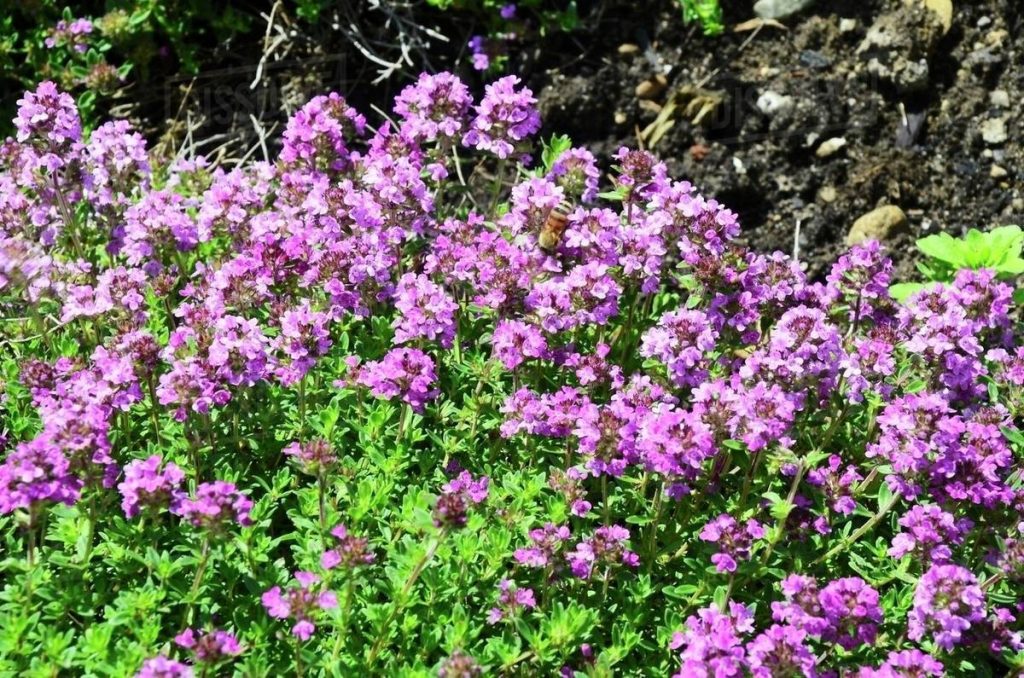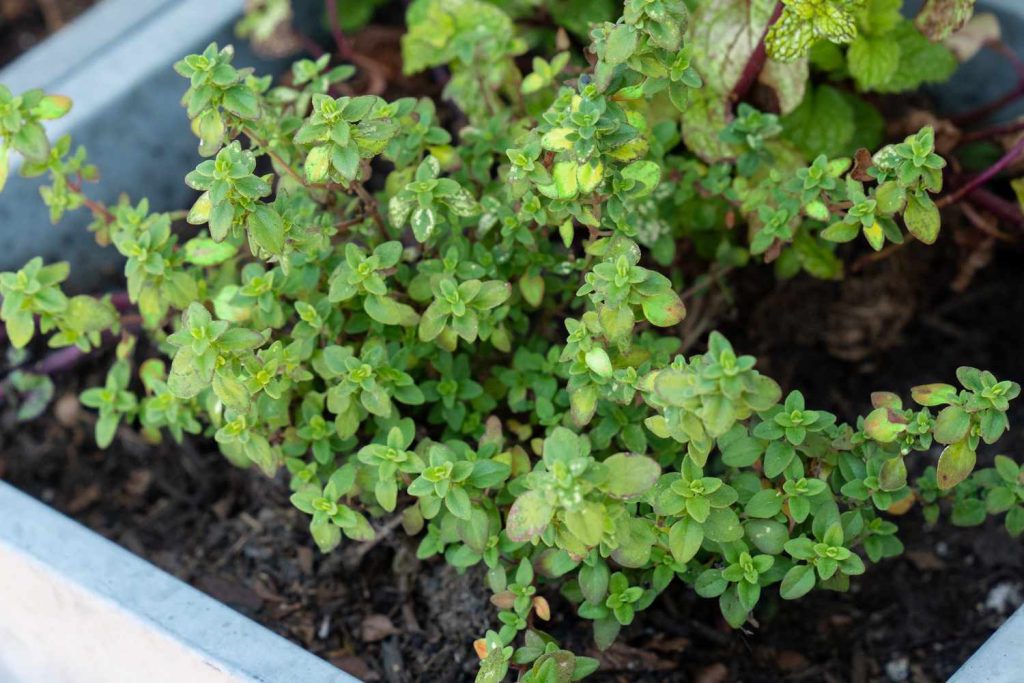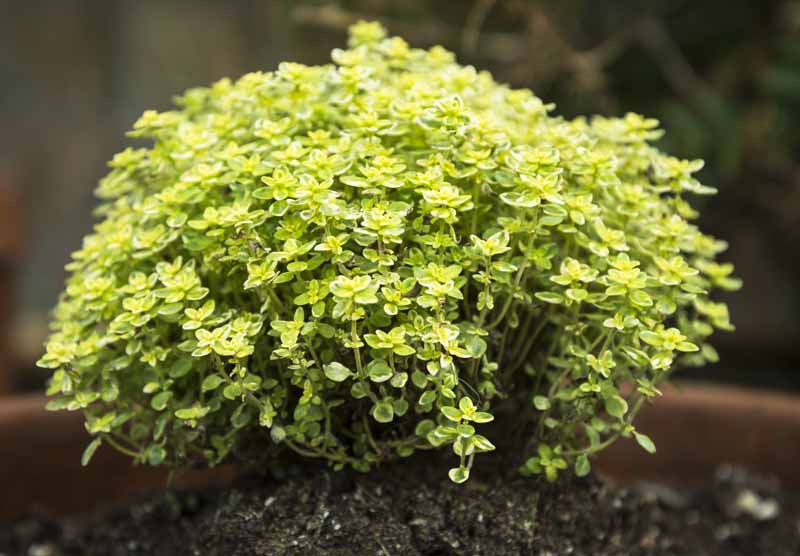Lemon thyme, a fragrant herbaceous shrub with lemon-scented leaves and purplish-pink flowers, is a resilient subshrub that adds value to both landscaping and culinary endeavors. With its low growth, evergreen foliage, and ability to withstand drought and heat, lemon thyme is a fantastic addition to any garden. It also offers the convenience of being harvestable for culinary purposes.
Are you curious about the ease of growing lemon thyme in your front or backyard? Do you want to know the basic care requirements for this fragrant Mediterranean shrub? This guide on caring for lemon thyme will address these inquiries and more. Moreover, you will find useful tips for resolving common problems that may arise when growing lemon thyme in your herb garden.
What exactly is Lemon Thyme (Thymus citriodorus)?

Lemon thyme (Thymus citriodorus) is an evergreen dwarf shrub with aromatic leaves.
Belonging to the mint family (Lamiaceae) and the Thymus genus, lemon thyme is a compact shrub with vibrant chartreuse-tinged evergreen foliage that emits a delightful citrusy aroma when the leaves are crushed. This aromatic herb showcases lavender-pink blossoms that bloom in early summer.
Also referred to as citrus thyme, this herbaceous shrub typically reaches a height of 6 to 12 inches (15 – 30 cm) and a width of 12 to 18 inches (30 – 45 cm). Its identifying features include compact growth, a rounded and bushy appearance, and bright green leaves that may have yellowish edges.
Lemon thyme thrives in full sun and dry to medium soil, making it an attractive shrub that performs well in various landscapes. Its long-lasting lilac-pink flowers are highly appealing to beneficial insects such as ladybugs and hoverflies, while bees and butterflies are frequently enticed by the fragrance and nectar of the flowers.
This citrus thyme variety is classified as an herbaceous evergreen shrub suitable for warm, dry climates. Its compact size and low growth make it suitable for gardens of any scale, whether as an edging plant along a driveway or a vibrant addition to containers on a patio or deck.
It is important to note that lemon thyme (Thymus citriodorus) should not be mistaken for another low-growing shrub with the same name, also known as lemon thyme (Thymus pulegioides). However, it is not uncommon for plants to share common names in the botanical world, which is why it is advisable to verify the botanical name when selecting plants for your garden.
How to Nurture Lemon Thyme
To care for lemon thyme, it is essential to plant the shrub in a sunny location with well-draining and relatively fertile soil. Since citrus thyme thrives in dry conditions, watering every two weeks or so is sufficient. Fertilizing is not necessary for lemon thyme growing in the ground.
Lemon Thyme Flowers

Lemon thyme (Thymus citriodorus) flowers.
Clusters of tiny lavender-pink, mauve, or light purple blossoms adorn the lemon thyme shrub. These decorative edible flowers bloom in early summer and persist until fall. The small tubular pinkish flowers serve as a significant nectar source for bees and butterflies, contributing to the citrusy aroma characteristic of lemon thyme.
Lemon Thyme Leaves
Lemon thyme’s foliage consists of small oval to lance-shaped leaves that emit a lemony fragrance. Many varieties feature dark green leaves with yellowish or creamy white margins. The evergreen nature of its foliage enhances the aesthetic value of lemon thyme in herb gardens, borders, and containers.
Variegated Lemon Thyme Leaves

Leaves of variegated lemon thyme.
Some lemon thyme shrubs exhibit variegated leaves, which are particularly eye-catching. Variegated lemon thyme may have chartreuse leaves with silvery margins or lime-scented green leaves with yellowish edges.
Varieties of variegated lemon thyme cultivars include:
– Thymus citriodorus ‘Variegata’ — Light green leaves with silvery margins.
– Thymus citriodorus ‘Silver-Edged’ — Leaves with thin silver margins contrasting with pink flowers.
– Thymus citriodorus ‘Creeping Golden Lemon’ — A creeping lemon thyme variety with variegated green and gold leaves and lavender flower spikes.
Creeping Lemon Thyme (Thymus pulegioides)

Creeping lemon thyme (Thymus pulegioides) spreads and is commonly used as ground cover.
Creeping lemon thyme, also known as broad-leaved thyme, is a spreading dwarf shrub with reddish woody stalks, rose-pink tubular flowers, and dark green leaves, sometimes with variegation. Resembling wild thyme (Thymus serpyllum), this creeping shrub has broader leaves on its woody shoots.
Growing 2 to 10 inches (5 – 25 cm) tall and up to 10 inches (25 cm) wide, this ground-hugging, horizontally spreading shrub finds utility in various landscape applications, such as ground cover for sunny areas, container planting, or growing in hanging baskets.
Lemon Thyme’s Landscape Applications

Variegated lemon thyme shrub serves as a versatile landscaping feature.
Lemon thyme is a versatile shrub that enhances landscapes. In the image: Variegated lemon thyme shrub.
Lemon thyme is a valuable herbaceous shrub for landscaping purposes. Its bushy, evergreen foliage, compact and upright growth habit, and invigorating lemon fragrance contribute to its appeal. Moreover, it adapts to most soils in full sunlight, as long as the ground has proper drainage. The pinkish tubular flowers add a splash of color throughout the summer.
Given its attractive visual attributes, fragrant blooms, and low maintenance requirements, lemon thyme is an excellent choice for various landscape applications. It can be utilized as ground cover, edging, foundation plantings, shrub borders, low-growing hedges, or container plants.
Furthermore, lemon thyme is easily propagated through cuttings, providing you with an abundance of new plants when the current shrubs outgrow their allocated space.
In addition to its visual appeal, lemon thyme is a prized addition to herb gardens. Its leaves can be harvested and used in salads, stews, soups, and Mediterranean dishes. The strong citrus flavor complements dishes featuring tomatoes, garlic, and olive oil.
Lemon Thyme as Ground Cover
Growing lemon thyme as ground cover is a simple task in sunny areas of your garden. When planted en masse, this low-growing shrub with scented foliage effectively covers bare patches. However, it primarily exhibits upright growth and may not be the best option for spreading across the ground.
If you desire a creeping thyme variety with flowers, you may consider wild thyme or Breckland thyme cultivars (Thymus serpyllum).
Identifying Lemon Thyme
Lemon thyme can be identified by its small dark green or chartreuse leaves, clusters of tiny purple-pink tubular flowers during summer, and compact and upright growth habit. At first glance, lemon thyme may resemble regular thyme shrubs, but crushing the
leaves will release its distinct citrusy aroma, allowing for easy differentiation.
Ideal Planting Locations for Lemon Thyme
The best location to plant lemon thyme in your garden is a sunny spot with good drainage. Citrus thyme thrives in dry, sandy, and rocky soils and can tolerate poor soils and drought. However, it is important to note that lemon thyme does not perform well in damp or shaded areas.
Lemon thyme is suitable for growth in USDA hardiness zones 6 through 9. For optimal growth, the planting location should receive at least six hours of daily sunlight. While fertile soil is preferred, the hardy shrub can adapt to various dry soil types.
Propagating Lemon Thyme
The simplest methods for propagating lemon thyme involve rooting stem cuttings or dividing established plants. Although it is possible to grow lemon thyme from seeds, germination can be a lengthy process.
Here are instructions for propagating lemon thyme shrubs:
Growing Lemon Thyme from Seed
To grow lemon thyme from seed, begin the process in late winter or early spring.
First, fill seed-starting pots with moist peat moss and place two or three seeds in each pot. Cover them with plastic wrap and position the pots in a sunny area near a bright window. Mist the soil daily to maintain moisture.
Once lemon thyme seedlings emerge, remove the plastic wrap and continue to keep the soil moist. Transfer the seedlings to individual pots when they reach a height of 3 inches (7.5 cm).
Once the seedlings have grown to a height of 4 to 5 inches (10 – 12.5 cm) and the threat of frost has passed, they can be transplanted into the garden. Water the newly planted lemon thyme shrubs regularly for the first few months to establish their roots.
Planting Lemon Thyme Cuttings
To propagate lemon thyme shrubs from cuttings, take stem cuttings measuring 3 to 4 inches (7.5 – 10 cm) from established plants in early spring. Remove the leaves from the lower half of the stem, leaving two or three at the top. Place the cutting in a small pot filled with well-draining potting soil.
Ensure that the cutting is buried about 2 inches (5 cm) into the soil and firmly press the soil around the stem. Thoroughly water the stem cutting and place the pot in a bright location away from direct sunlight. Keep the potting medium consistently moist.
After four to six weeks, you should observe new leaves emerging. Once the new growth is visible, you can transplant the lemon thyme shrub cutting into a sunny spot in the garden.
Propagating Lemon Thyme Shrubs by Division
You can expand your lemon thyme population by dividing an established, mature shrub. Division can be done in early spring or late fall. Follow these steps:
Dig up the plant, ensuring that you retrieve all the roots, and shake off any excess soil. Proceed to divide the plant’s root system into three or four smaller sections. Take care to untangle the roots with minimal damage.
Plant the new shrubs in the sunniest area of your garden. Propagating lemon thyme through division is an excellent method for establishing an evergreen low hedgerow. The shrubs can be planted as edging along a pathway or grown in containers to adorn an entranceway.
Growing Lemon Thyme in Pots

Lemon thyme in a pot.
Lemon thyme, a miniature herbaceous evergreen shrub, thrives when planted in pots. The potting soil should be moderately fertile and supplemented with perlite for improved drainage. Ideally, the pot, such as a terracotta one, should feature
multiple drainage holes to prevent the potting soil from becoming waterlogged.
To care for a potted lemon thyme plant, water the soil whenever the top 3 inches (7.5 cm) feels dry. Ensure thorough watering, allowing excess water to drain from the pot’s holes. Place the potted citrus thyme shrub in a sunny location.
Lemon Thyme Care Guide
Lemon thyme is one of the easiest herbs to cultivate. The most crucial care requirement for this herb is planting it in moderately dry, well-draining soil and providing ample sunlight.
Here are some key tips for successfully growing lemon thyme in your landscape:
Watering Lemon Thyme
Established lemon thyme shrubs only require watering when the soil becomes parched. Water thoroughly to ensure the moisture reaches the deep roots. In hot summers, watering once or twice a month may suffice.
Newly planted lemon thyme shrubs, however, need regular watering for a couple of months to establish their roots. Afterward, watering can be reduced to whenever the top two inches of soil are dry. With occasional rainfall, you may rarely need to water a lemon thyme shrub.
Temperature and Humidity for Lemon Thyme
Lemon thyme thrives in warmer temperatures with low humidity. These conditions promote the shrub’s blooming throughout the summer, adding a splash of purple to your garden landscape. Warm and dry weather also allows the citrusy essential oils to permeate the air, filling your garden with lemon scents.
In cooler climates within zones 5 and 6, lemon thyme goes dormant during winter. Nevertheless, the shrubs typically retain their foliage, providing greenery from November through spring.
When growing lemon thyme indoors, maintain a temperature range of 65°F to 85°F (18°C – 29°C). Moderate humidity is suitable for indoor lemon thyme, and the shrub thrives when exposed to approximately five hours of sunlight daily.
Pruning Lemon Thyme Shrubs
Lemon thyme has minimal pruning requirements. You can trim back the stems after flowering to encourage new growth. However, many gardeners opt to let the shrub grow naturally without pruning.
Should You Fertilize Lemon Thyme?
Fertilization is not necessary for lemon thyme growing in the ground. The shrub adapts well to nutrient-deficient soils, although it performs best in average soil. Adding a small amount of organic compost can promote overall plant health.
Issues When Growing Lemon Thyme in the Garden
Lemon thyme is a resilient shrub that is rarely affected by pests or diseases when in good health. However, aphids or spider mites may occasionally pose a minor nuisance, particularly if the shrub is overwatered, leading to fungal diseases.
Here are solutions to common issues that may affect lemon thyme growth:
Aphids: These pests are bothersome but generally do not cause severe harm to lemon thyme. They are small, light green bugs found on the undersides of leaves. Signs of aphids on plants may include leaf curling, yellowing, or wrinkled and brittle leaves. To eliminate aphids from lemon thyme, use a garden hose to dislodge them with short, sharp blasts of water.
Spider Mites: Spider mites are difficult to spot on lemon thyme shrubs but generally do not cause significant damage. Signs of spider mites include tiny web-like strands hanging from leaves. Similar to aphids, you can remove spider mites by blasting them with water from a hose.
Foliar Diseases: Fungal diseases, characterized by yellow leaves, dieback, or poor growth, usually occur in warm and humid climates. These issues can also arise due to poor soil drainage or overwatering. To prevent slow growth,
allow the soil to dry out between waterings. When watering the shrub, focus on thoroughly watering the soil and avoid splashing water on the leaves. Staking upright stems can also help prevent leaves from coming into contact with the ground and reduce the risk of fungal or bacterial diseases. If signs of rot are present, remove all affected stems and foliage, and dispose of them.
Harvesting and Preserving Lemon Thyme Leaves
Lemon thyme leaves can be harvested at any time of year, preferably in the morning or just after sunset. Simply snip a few inches of the stems just above a node to harvest the aromatic leaves and stems.
To preserve the citrusy and herbal flavors of lemon thyme leaves, bundle several twigs together, tie them with twine, and hang them in a dark and warm place to dry completely. Alternatively, you can oven-dry them at a low temperature for two to four hours.